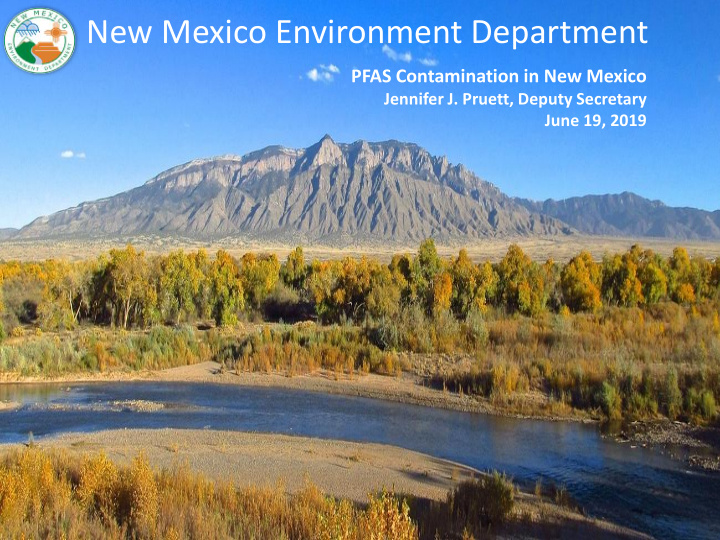



New Mexico Environment Department PFAS Contamination in New Mexico Jennifer J. Pruett, Deputy Secretary June 19, 2019
NMED’s Guiding Principles Science – Using the best available science to inform our decision- making in protecting public health and the environment. Innovation – Employing creative engineering and technological solutions to address environmental problems. Collaboration – Engaging communities and interested stakeholders in environmental decision-making. Compliance – Ensuring meaningful compliance with state regulations and permits. 2
What are PFAS? Perfluoroalkyl and polyfluoroalkyl substances (PFAS) are a family of man-made chemicals PFAS are mobile and persistent in groundwater PFAS are what’s known as “emerging contaminants” Risks to human health and the environment are not fully understood Lacking peer-reviewed human health standards Evolving federal and state standards and regulations No national EPA standards 3
PFAS uses and applications Building and Chemicals and Electronics Apparel Aqueous Film- Construction Pharmaceuticals Forming Foam Energy Healthcare Semiconductors Oil & Gas Aerospace and Hospitals 4
Cannon Air Force Base 2015 - The United States Air Force (USAF) begins studying the potential for PFAS releases at CAFB. August 2018 -The USAF discloses the results of their study to NMED. November 2018 – NMED issues Notice of Violation (NOV) under authority of the Water Quality Act to the USAF for failing to contain and remove/mitigate the damage caused by its discharge of PFAS into groundwater. December 2018 – NMED requires the USAF to conduct corrective actions pursuant to its hazardous waste permit. January 2019 – USAF challenges NMED’s authority to require corrective action pursuant to their hazardous waste permit. March 2019 – NMED and the NM Office of the Attorney General (NMAG) sue the USAF seeking action on the imminent and substantial endangerment caused by PFAS pollution. 5
DRAFT 4/22/19 PFAS Area of Concern
Water Testing PFAS contamination in New Mexico is one of the Governor’s and the New Mexico Environment Department’s top priorities. Agencies collected 90 water samples from owners of private wells within 4 miles of the CAFB boundary. PFAS were detected in 1 house served by a public water cooperative and in 2 private domestic wells. No PFAS were detected at entry points (where water enters the system to be delivered to customers) in Cannon’s or Clovis’ drinking water system. Sampling data can be found at: https://www.env.nm.gov/pfas/data/ 7
NMED’s Role in PFAS Contamination NMED has primacy in enforcing hazardous waste regulations under the Resource Conservation and Recovery Act (RCRA). NMED has authority to protect ground water under the Water Quality Act (WQA). NMED does not have authority to clean up sites, it only has authority to compel and approve clean up plans. 8
Lawsuit Against the Air Force In March 2019, the NMED, in conjunction with the NM Attorney General, filed suit against the USAF to hold the Air Force accountable for the contamination caused by decades of PFAS discharged at Cannon and Holloman Air Force bases. The state is requesting immediate injunctive relief from the court that requires the Air Force to delineate the extent of contamination and take steps to protect public health and the environment. 9
Path forward In February 2019, the US EPA announced its PFAS “action plan,” which includes the development of maximum contaminant levels (MCLs) for PFOS and PFOA under the Safe Drinking Water Act, to start at the end of 2019. PFAS contamination is a high priority, and state agencies will continue protecting public health and the environment (NMED with Departments of Health and Agriculture). NMED maintains a PFAS website with data and information https://www.env.nm.gov/pfas/main/ NMED will continue to use science to inform our decisions going forward and take whatever options available to hold the Air Force accountable. 10
Recommend
More recommend